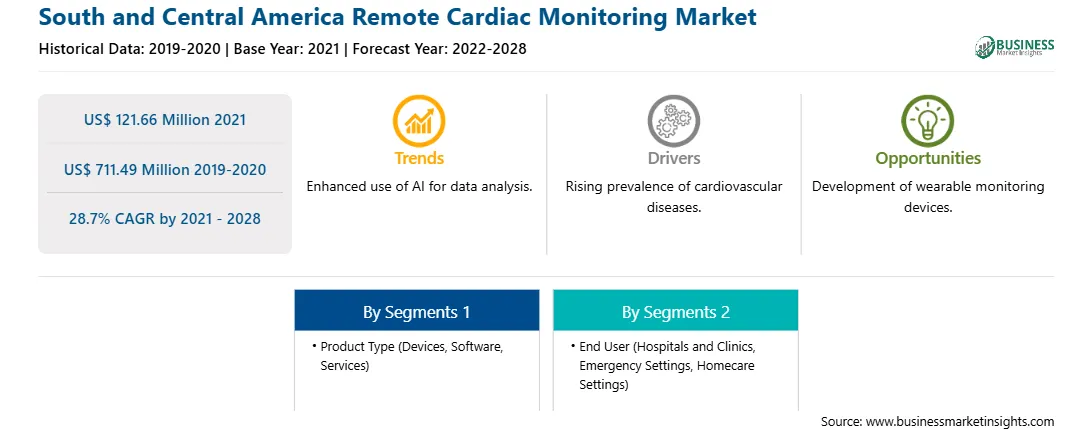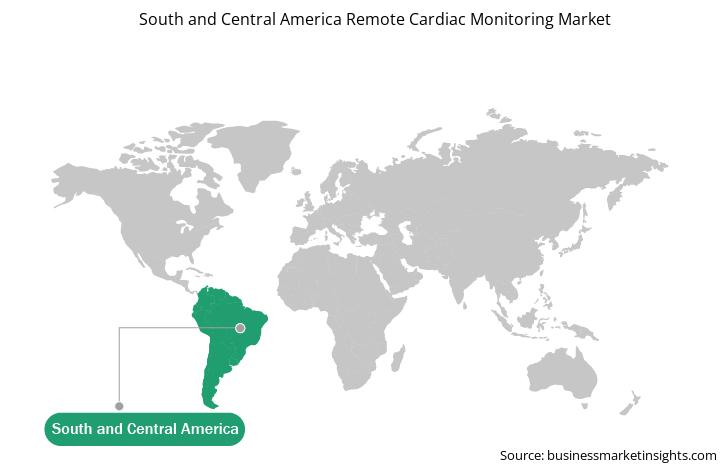South and Central America region for the estimating the market for the remote cardiac monitoring is cumulative of Brazil, Argentina, and rest of South and Central America. The region held the smallest portion of the global market. The region is likely to witness noticeable growth in the forecasted period owing to the recent technological developments which have made a direct impact on the economy of Brazil that has advanced to a large extent. Cost savings advantage and higher work efficiencies achieved are cited as the major attracting points for manufacturing companies to establish bases in South America. Brazil has around 200 million inhabitants and is the fifth largest country in the world. Brazil comprises 26 states that extend over 876,599 km² and have regions with both high (southeast) and lower population density (north). According to the study report by Gagnon-Arpin et al. from 2017, the prevalence of cardiovascular disease (CVD) among Brazilian adults is projected to rise to 13.6 million by 2035, while the economic burden, including direct and indirect costs would rise to around US$ 40 billion. Furthermore, owing to the increasing awareness of various heart diseases in Brazil along with the increasing number of the elderly population is expected to show significant growth in the forecasted period thus providing opportunities for the market. According to the World Health Organization (WHO) in 2017, about 164,557 or 15.56% of total deaths in Brazil were attributable to deaths from coronary artery disease and was considered one the leading causes of death. This can be reduced slightly by the effective introduction of remote cardiac monitoring. Additionally, due to the increase in cardiovascular disease in the country, the introduction of these devices may help monitor heart disease. Hence, based on the above factors, the market is expected to see a healthy growth rate soon.
Market participants and end users are losing their business due to the temporary closure of companies in different regions because of COVID-19 pandemic. The second wave of COVID-19 affected Brazil, Argentina, Uruguay, Chile, Peru, and Colombia, among which Brazil recorded the highest number of deaths. In this situation, there was discontinuation of physiotherapy and other related treatments. An adverse side effect of the lockdown restricted access to health system facilities, which impacted the treatment and management of acute and chronic cardiovascular diseases. Long before the COVID-19 pandemic changed people's lives, remote heart monitoring devices had emerged as a viable way to overcome the long intervals between doctor visits, remotely monitor patients, and protect them by preventing the progression of the disease recognized in time to prevent hospitalization. The onset of COVID-19 pandemic has further accelerated the demand for remote cardiac monitoring, which is subsequently driving its market..

Strategic insights for the South and Central America Remote Cardiac Monitoring provides data-driven analysis of the industry landscape, including current trends, key players, and regional nuances. These insights offer actionable recommendations, enabling readers to differentiate themselves from competitors by identifying untapped segments or developing unique value propositions. Leveraging data analytics, these insights help industry players anticipate the market shifts, whether investors, manufacturers, or other stakeholders. A future-oriented perspective is essential, helping stakeholders anticipate market shifts and position themselves for long-term success in this dynamic region. Ultimately, effective strategic insights empower readers to make informed decisions that drive profitability and achieve their business objectives within the market.

| Report Attribute | Details |
|---|---|
| Market size in 2021 | US$ 121.66 Million |
| Market Size by 2028 | US$ 711.49 Million |
| Global CAGR (2021 - 2028) | 28.7% |
| Historical Data | 2019-2020 |
| Forecast period | 2022-2028 |
| Segments Covered |
By Product Type
|
| Regions and Countries Covered | South and Central America
|
| Market leaders and key company profiles |
The geographic scope of the South and Central America Remote Cardiac Monitoring refers to the specific areas in which a business operates and competes. Understanding local distinctions, such as diverse consumer preferences (e.g., demand for specific plug types or battery backup durations), varying economic conditions, and regulatory environments, is crucial for tailoring strategies to specific markets. Businesses can expand their reach by identifying underserved areas or adapting their offerings to meet local demands. A clear market focus allows for more effective resource allocation, targeted marketing campaigns, and better positioning against local competitors, ultimately driving growth in those targeted areas.

The remote cardiac monitoring market in SCAM is expected to grow from US$ 121.66 million in 2021 to US$ 711.49 million by 2028; it is estimated to grow at a CAGR of 28.7% from 2021 to 2028. Increase in incidence of cardiovascular diseases; remote patient monitoring (RPM) allows patients to manage their health better by increasing their involvement in their health care. Hypertension is a significant risk factor for CVD. RPM may serve as a vital conduit for improving hypertension control and reducing the economic burden stemming from prolonged or frequent hospital stays that result from acute hypertension-related events. Research has shown that RPM can significantly lower systolic blood pressure (SBP) and diastolic blood pressure (DBP) compared to usual care and self-monitoring alone. According to a few non-randomized trials, RPM can improve outcomes by enabling accurate and early detection as well as decreasing all-cause mortality rates and hospitalizations. Recent clinical guidelines strongly recommend the use of RPM for atrial fibrillation (AF) detection in both stroke and non-stroke patients. This is bolstering the growth of the remote cardiac monitoring market.
Based on product type, the market is segmented into devices, software, and services. In 2021, the devices segment held the largest share SCAM remote cardiac monitoring market. Based on devices the market is divided into vital signs monitors, heart rate monitors, blood pressure monitors, breath monitors, holter monitors, and others. Vital signs monitors is expected to the fastest growing segment over the forecast period. Based on software the market is divided into cloud based software and on-premise software. The cloud based software segment accounts for largest market share in the 2021. Similarly, based on end user, the market is segmented into hospitals and clinics, emergency settings, homecare settings and others. In 2021, the hospitals and clinics segment held the largest share of the market.
A few major primary and secondary sources referred to for preparing this report on the remote cardiac monitoring market in SCAM are company websites, annual reports, financial reports, national government documents, and statistical database, among others. Major companies listed in the report are Abbott; Biotronik, Inc.; Boston Scientific Corporation; Honeywell International Inc.; Koninklijke Philips N.V.; Medtronic; Nihon Kohden Corporation; and OSI Systems, Inc. among others.
The South and Central America Remote Cardiac Monitoring Market is valued at US$ 121.66 Million in 2021, it is projected to reach US$ 711.49 Million by 2028.
As per our report South and Central America Remote Cardiac Monitoring Market, the market size is valued at US$ 121.66 Million in 2021, projecting it to reach US$ 711.49 Million by 2028. This translates to a CAGR of approximately 28.7% during the forecast period.
The South and Central America Remote Cardiac Monitoring Market report typically cover these key segments-
The historic period, base year, and forecast period can vary slightly depending on the specific market research report. However, for the South and Central America Remote Cardiac Monitoring Market report:
The South and Central America Remote Cardiac Monitoring Market is populated by several key players, each contributing to its growth and innovation. Some of the major players include:
The South and Central America Remote Cardiac Monitoring Market report is valuable for diverse stakeholders, including:
Essentially, anyone involved in or considering involvement in the South and Central America Remote Cardiac Monitoring Market value chain can benefit from the information contained in a comprehensive market report.